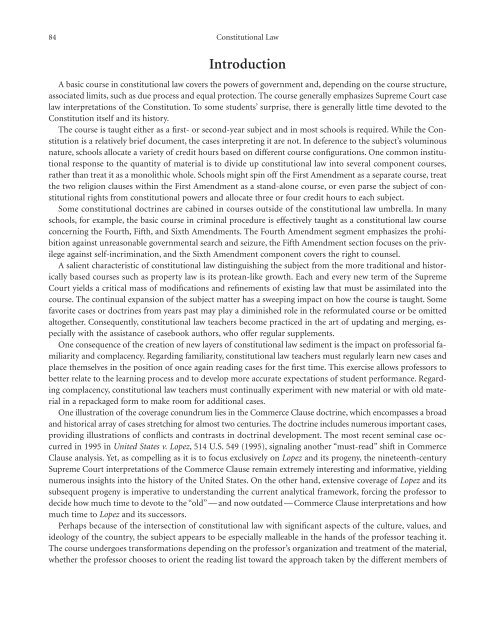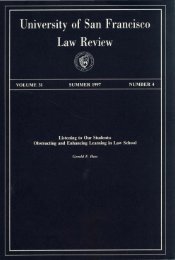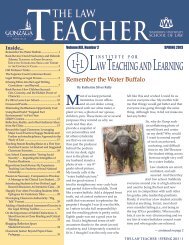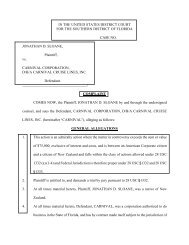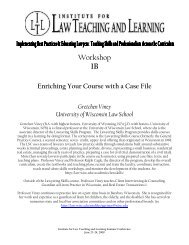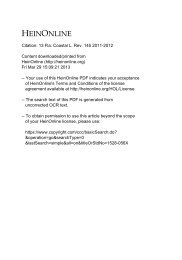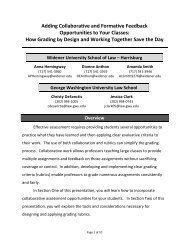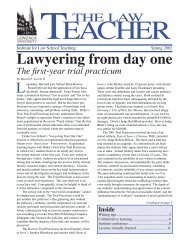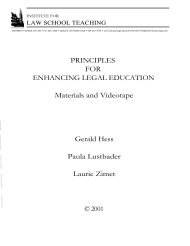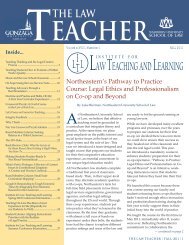Teaching the Law School Curriculum - Institute for Law Teaching ...
Teaching the Law School Curriculum - Institute for Law Teaching ...
Teaching the Law School Curriculum - Institute for Law Teaching ...
You also want an ePaper? Increase the reach of your titles
YUMPU automatically turns print PDFs into web optimized ePapers that Google loves.
84 Constitutional <strong>Law</strong><br />
Introduction<br />
A basic course in constitutional law covers <strong>the</strong> powers of government and, depending on <strong>the</strong> course structure,<br />
associated limits, such as due process and equal protection. The course generally emphasizes Supreme Court case<br />
law interpretations of <strong>the</strong> Constitution. To some students’ surprise, <strong>the</strong>re is generally little time devoted to <strong>the</strong><br />
Constitution itself and its history.<br />
The course is taught ei<strong>the</strong>r as a first- or second-year subject and in most schools is required. While <strong>the</strong> Constitution<br />
is a relatively brief document, <strong>the</strong> cases interpreting it are not. In deference to <strong>the</strong> subject’s voluminous<br />
nature, schools allocate a variety of credit hours based on different course configurations. One common institutional<br />
response to <strong>the</strong> quantity of material is to divide up constitutional law into several component courses,<br />
ra<strong>the</strong>r than treat it as a monolithic whole. <strong>School</strong>s might spin off <strong>the</strong> First Amendment as a separate course, treat<br />
<strong>the</strong> two religion clauses within <strong>the</strong> First Amendment as a stand-alone course, or even parse <strong>the</strong> subject of constitutional<br />
rights from constitutional powers and allocate three or four credit hours to each subject.<br />
Some constitutional doctrines are cabined in courses outside of <strong>the</strong> constitutional law umbrella. In many<br />
schools, <strong>for</strong> example, <strong>the</strong> basic course in criminal procedure is effectively taught as a constitutional law course<br />
concerning <strong>the</strong> Fourth, Fifth, and Sixth Amendments. The Fourth Amendment segment emphasizes <strong>the</strong> prohibition<br />
against unreasonable governmental search and seizure, <strong>the</strong> Fifth Amendment section focuses on <strong>the</strong> privilege<br />
against self-incrimination, and <strong>the</strong> Sixth Amendment component covers <strong>the</strong> right to counsel.<br />
A salient characteristic of constitutional law distinguishing <strong>the</strong> subject from <strong>the</strong> more traditional and historically<br />
based courses such as property law is its protean-like growth. Each and every new term of <strong>the</strong> Supreme<br />
Court yields a critical mass of modifications and refinements of existing law that must be assimilated into <strong>the</strong><br />
course. The continual expansion of <strong>the</strong> subject matter has a sweeping impact on how <strong>the</strong> course is taught. Some<br />
favorite cases or doctrines from years past may play a diminished role in <strong>the</strong> re<strong>for</strong>mulated course or be omitted<br />
altoge<strong>the</strong>r. Consequently, constitutional law teachers become practiced in <strong>the</strong> art of updating and merging, especially<br />
with <strong>the</strong> assistance of casebook authors, who offer regular supplements.<br />
One consequence of <strong>the</strong> creation of new layers of constitutional law sediment is <strong>the</strong> impact on professorial familiarity<br />
and complacency. Regarding familiarity, constitutional law teachers must regularly learn new cases and<br />
place <strong>the</strong>mselves in <strong>the</strong> position of once again reading cases <strong>for</strong> <strong>the</strong> first time. This exercise allows professors to<br />
better relate to <strong>the</strong> learning process and to develop more accurate expectations of student per<strong>for</strong>mance. Regarding<br />
complacency, constitutional law teachers must continually experiment with new material or with old material<br />
in a repackaged <strong>for</strong>m to make room <strong>for</strong> additional cases.<br />
One illustration of <strong>the</strong> coverage conundrum lies in <strong>the</strong> Commerce Clause doctrine, which encompasses a broad<br />
and historical array of cases stretching <strong>for</strong> almost two centuries. The doctrine includes numerous important cases,<br />
providing illustrations of conflicts and contrasts in doctrinal development. The most recent seminal case occurred<br />
in 1995 in United States v. Lopez, 514 U.S. 549 (1995), signaling ano<strong>the</strong>r “must-read” shift in Commerce<br />
Clause analysis. Yet, as compelling as it is to focus exclusively on Lopez and its progeny, <strong>the</strong> nineteenth-century<br />
Supreme Court interpretations of <strong>the</strong> Commerce Clause remain extremely interesting and in<strong>for</strong>mative, yielding<br />
numerous insights into <strong>the</strong> history of <strong>the</strong> United States. On <strong>the</strong> o<strong>the</strong>r hand, extensive coverage of Lopez and its<br />
subsequent progeny is imperative to understanding <strong>the</strong> current analytical framework, <strong>for</strong>cing <strong>the</strong> professor to<br />
decide how much time to devote to <strong>the</strong> “old” — and now outdated — Commerce Clause interpretations and how<br />
much time to Lopez and its successors.<br />
Perhaps because of <strong>the</strong> intersection of constitutional law with significant aspects of <strong>the</strong> culture, values, and<br />
ideology of <strong>the</strong> country, <strong>the</strong> subject appears to be especially malleable in <strong>the</strong> hands of <strong>the</strong> professor teaching it.<br />
The course undergoes trans<strong>for</strong>mations depending on <strong>the</strong> professor’s organization and treatment of <strong>the</strong> material,<br />
whe<strong>the</strong>r <strong>the</strong> professor chooses to orient <strong>the</strong> reading list toward <strong>the</strong> approach taken by <strong>the</strong> different members of


